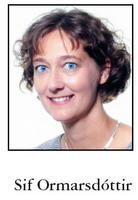Fræðigreinar
Nýr doktor í læknisfræði. Beingisnun í langvinnum lifrarsjúkdómi
Þann 15. maí síðastliðinn varði Sif Ormarsdóttir doktorsritgerð sína við Uppsalaháskóla. Ritgerðin ber heitið Osteoporosis in Chronic Liver Disease. Andmælandi var Rolf Hultcrantz, prófessor við Stokkhólmsháskóla. Handleiðarar voru dósentarnir Lars Lööf, Östen Ljunggren og Hans Mallmin. Hér birtist enskt ágrip ritgerðarinnar:
Osteoporosis is a well-known and frequently reported complication of chronic liver disease (CLD) with a high fracture rate contributing to significant morbidity after liver transplantation. The pathogenesis is unknown and controversy exists about many risk factors for osteoporosis in CLD.
In the present thesis, bone mineral density (BMD) was found to be significantly lower at the lumbar spine (p<0.01) in a cohort of patients with CLD compared with age- and gender-matched individuals. Osteoporosis was found in 30% of the patients and 15% of the controls, respectively. Low body mass index (BMI), corticosteroid treatment, prothrombin time, age and female gender were independent risk factors for osteoporosis in the patients.
In a follow-up study, 43 of 72 patients were available for a second BMD measurement 25 months (median) after the first. Bone loss at the femoral neck was 1.5±2.4% in females and 2.9±2.0% in males with a significant decrease in BMD Z-score over time (p=0.005 and p=0.02 for females and males, respectively), indicating increased bone loss at this site. Hyperbilirubinaemia and low circulating levels of 25-hydroxy vitamin D3 predicted increased bone loss at the femoral neck. These findings suggest that cortical bone, in addition to trabecular bone, may be affected in CLD and bilirubin and vitamin D3 may be involved in the pathophysiology of osteoporosis in CLD.
In order to elucidate the suggested role of insulin-like growth factors (IGFs) and leptin in the pathophysiology of osteoporosis in CLD, we studied the relationship between these factors and BMD. Levels of IGFs were extremely low (p<0.0001 compared with the controls) and related to liver function but no correlation was found between the IGFs and BMD. Serum leptin adjusted for BMI correlated negatively with BMD in female patients (p=0.003 and p=0.04 at the lumbar spine and the femoral neck, respectively) and in male patients at the femoral neck (p=0.04). Thus, the IGFs appear not to be involved in the pathophysiology of osteoporosis in CLD but a role of circulating leptin is possible.

